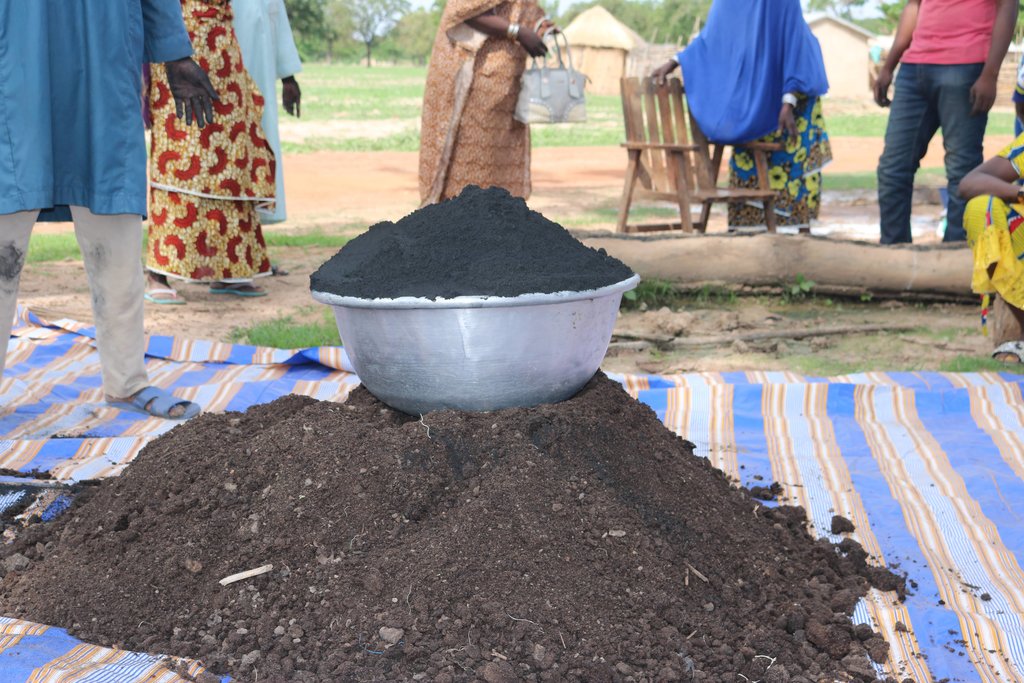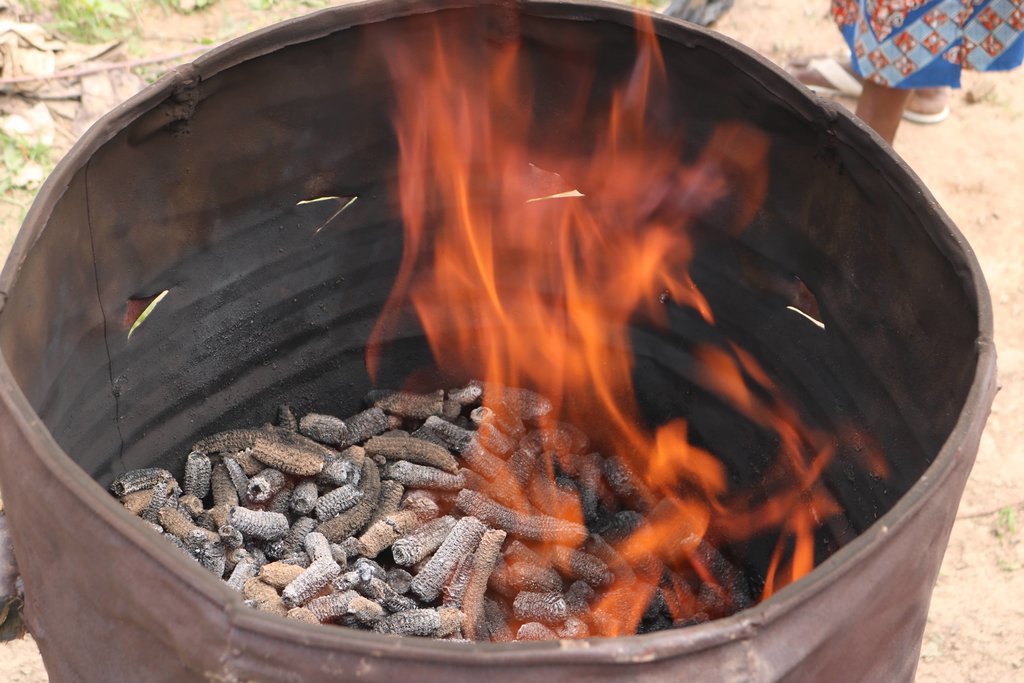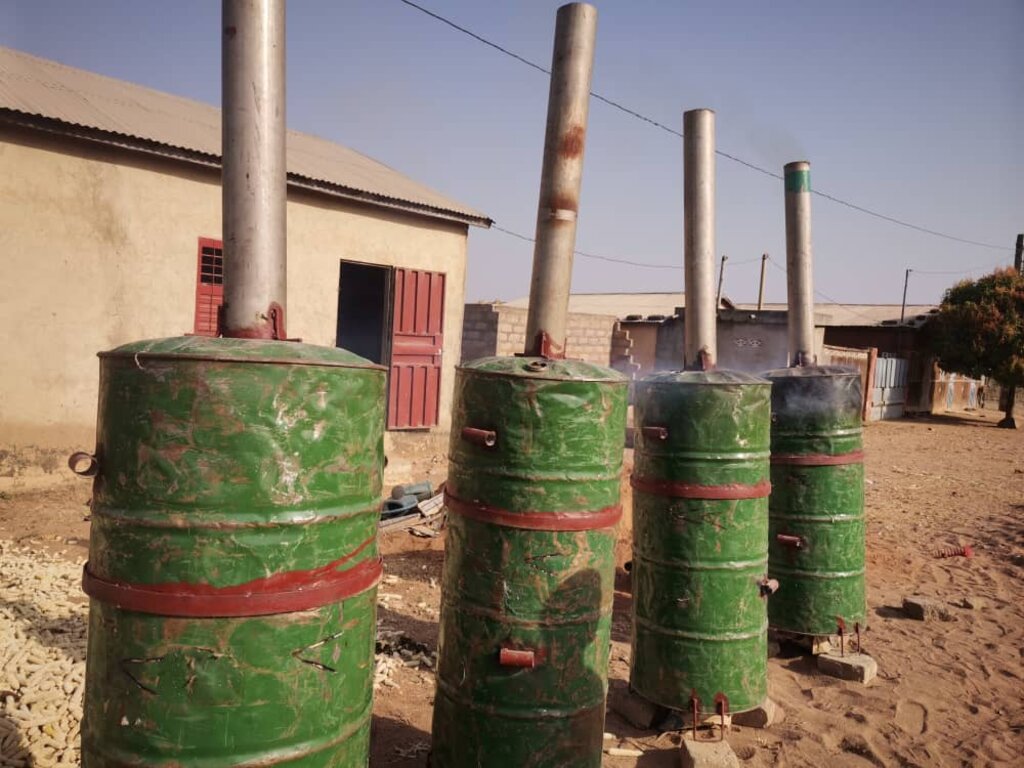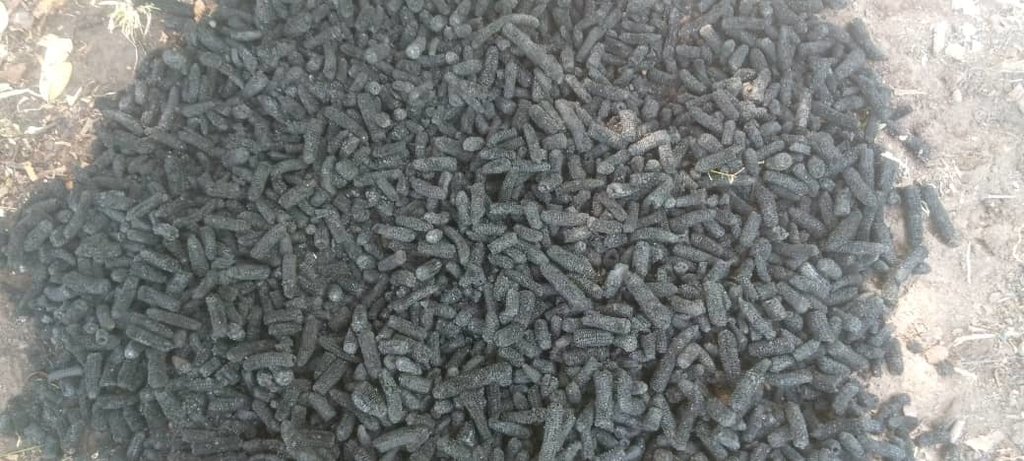Biochar Production and Application to Improve Soils [Benin]
- Creation:
- Update:
- Compiler: Gatien AGBOKOUN CHRISTOPHE
- Editors: Siagbé Golli, Abdoul Karim MIEN, DOSSOU-YOVO bernardin, Tabitha Nekesa, Ahmadou Gaye
- Reviewers: Sally Bunning, Rima Mekdaschi Studer, William Critchley
technologies_6665 - Benin
View sections
Expand all Collapse all1. General information
1.2 Contact details of resource persons and institutions involved in the assessment and documentation of the Technology
Key resource person(s)
SLM specialist:
BROUBROUI Alidou
AFVA / Banikoara
Benin
land user:
GARADIMA Yakoia
AFVA / Banikoara
Benin
land user:
WAGOUSSOUNON Bona Sema
AFVA / Banikoara
Benin
Name of project which facilitated the documentation/ evaluation of the Technology (if relevant)
Soil protection and rehabilitation for food security (ProSo(i)l)Name of the institution(s) which facilitated the documentation/ evaluation of the Technology (if relevant)
GIZ Bénin (GIZ Bénin) - Benin1.3 Conditions regarding the use of data documented through WOCAT
The compiler and key resource person(s) accept the conditions regarding the use of data documented through WOCAT:
Yes
1.4 Declaration on sustainability of the described Technology
Is the Technology described here problematic with regard to land degradation, so that it cannot be declared a sustainable land management technology?
No
2. Description of the SLM Technology
2.1 Short description of the Technology
Definition of the Technology:
Biochar is generated through the process of pyrolysis (partial combustion) of plant biomass like corn cobs or forest residues, in a heat-intensive, oxygen-free or low-oxygen environment. By spreading biochar on fields, the objective is to enhance the nutrient-holding capacity and structure of soil, and thereby to improve plant production.
2.2 Detailed description of the Technology
Description:
Biochar, a residue from the pyrolysis (partial combustion or “thermal decomposition”) of organic matter, can be used as a soil improver. The equipment required for its production is a pyrolysis system (e.g. a drum with a capacity of at least 120 L) and a biochar collection shovel. The biochar production process documented here involves burning corn cobs and crop stalks in a drum that is hermetically sealed with a lid and fitted with a vent. The drum is opened as soon as the residues are completely carbonized (at which point the smoke no longer emerges from the vent). This means the following requirements must be met:
• H/C (degree of carbonation): 0.38
• pH > 8, zero neutralizing value
• Raw (90% < 30mm)
• Ground (90% < 3mm)
The burnt residues are scooped up and cooled down with water. Then, the charred residues are scattered in the crop field. To ensure effective mixing with other fertilizing agents (compost, fertilizers, etc.), the residues must be finely ground. For tropical soils, experts recommend spreading 5 tons of biochar per hectare. To produce 1 ton of biochar, approximately 6 tons of cobs are needed, equivalent to around 12 hectares of maize. This dosage needs to be renewed every 50 years. However, in intensive market gardening with limited space, a higher dosage of up to 10 tons per hectare, or 1 kg per square meter, can be applied.
The recommended reduced dosage of biochar per hectare is 100 kg of ground biochar mixed with the NPK fertilizer dose for the specific crop to be spread 2 weeks after sowing (150 kilograms of NPK for maize or cotton). In practice, two volumes of biochar should be added for every volume of NPK fertilizer. Depending on the availability of organic fertilizer, an additional two or three volumes of compost or well-decomposed manure can be added, and the dosage of biochar should be renewed annually.
To ensure sustainability and scalability, it is important to:
•add organic matter to the biochar to enhance soil fertility;
•train a large number of farmers; and
•ensure easy access to biochar kilns.
This technology offers several advantages, including :
•increased plant growth;
•improved soil structure and physical properties;
•enhanced water retention capacity of the soil;
•increased availability of nutrients in the soil;
•promotion of humus formation;
•creation of a sustainable habitat for microorganisms due to its porous structure;
•accelerated composting and reduction of smells;
•long-term carbon storage in the soil; and
•reduced soil acidity and improved effectiveness of organic and mineral soil enhancers.
Applying biochar to crops helps increase yields. For example, a plot without biochar yielded 1,000 kg/ha of cotton, while a plot with biochar yielded 1,740 kg/ha, resulting in a 74% increase. Similarly, maize yield can be improved by approximately 31% with the application of biochar.
2.3 Photos of the Technology
2.5 Country/ region/ locations where the Technology has been applied and which are covered by this assessment
Country:
Benin
Region/ State/ Province:
Banikoara
Further specification of location:
Women's market garden
Specify the spread of the Technology:
- evenly spread over an area
If the Technology is evenly spread over an area, specify area covered (in km2):
0.25
Is/are the technology site(s) located in a permanently protected area?
Yes
If yes, specify:
This is a market-gardening perimeter owned by women, who have erected a fence to prevent animal encroachment.
Map
×2.6 Date of implementation
Indicate year of implementation:
2016
2.7 Introduction of the Technology
Specify how the Technology was introduced:
- through projects/ external interventions
Comments (type of project, etc.):
The use of biochar was facilitated by ProSOL
3. Classification of the SLM Technology
3.1 Main purpose(s) of the Technology
- improve production
- reduce, prevent, restore land degradation
- mitigate climate change and its impacts
- create beneficial economic impact
- create beneficial social impact
3.2 Current land use type(s) where the Technology is applied
Land use mixed within the same land unit:
No

Cropland
- Annual cropping
Annual cropping - Specify crops:
- vegetables - leafy vegetables (salads, cabbage, spinach, other)
Number of growing seasons per year:
- 2
Specify:
Market gardening occurs during the off-season, with cycles being renewed prior to the onset of the rainy season.
Is intercropping practiced?
No
Is crop rotation practiced?
Yes
If yes, specify:
At the market garden site, the women engage in crop rotation, ensuring that vegetables are not systematically planted twice on the same plot. They follow a rotation schedule based on the crops grown by the market gardeners.
3.3 Has land use changed due to the implementation of the Technology?
Has land use changed due to the implementation of the Technology?
- Yes (Please fill out the questions below with regard to the land use before implementation of the Technology)
Land use mixed within the same land unit:
No

Cropland
- Annual cropping
Annual cropping - Specify crops:
- fodder crops - grasses
- vegetables - leafy vegetables (salads, cabbage, spinach, other)
- vegetables - root vegetables (carrots, onions, beet, other)
Is intercropping practiced?
No
Is crop rotation practiced?
Yes
If yes, specify:
Market garden crops are rotated to limit pest attacks.
3.4 Water supply
Water supply for the land on which the Technology is applied:
- mixed rainfed-irrigated
Comments:
Regarding irrigation, the women at the production sites have wells available. They extract water from these wells and utilize watering cans to efficiently irrigate their plants.
3.5 SLM group to which the Technology belongs
- improved ground/ vegetation cover
- integrated soil fertility management
- post-harvest measures
3.6 SLM measures comprising the Technology

agronomic measures
- A1: Vegetation/ soil cover
- A2: Organic matter/ soil fertility

management measures
- M1: Change of land use type
- M6: Waste management (recycling, re-use or reduce)
3.7 Main types of land degradation addressed by the Technology

soil erosion by water
- Wt: loss of topsoil/ surface erosion

soil erosion by wind
- Et: loss of topsoil

chemical soil deterioration
- Cn: fertility decline and reduced organic matter content (not caused by erosion)

biological degradation
- Bl: loss of soil life
3.8 Prevention, reduction, or restoration of land degradation
Specify the goal of the Technology with regard to land degradation:
- restore/ rehabilitate severely degraded land
4. Technical specifications, implementation activities, inputs, and costs
4.1 Technical drawing of the Technology
Technical specifications (related to technical drawing):
Biochar can be produced through pyrolysis, using either a 250-liter barrel as a pyrolyzer or a cone-shaped hole as a curie-point pyrolyzer. If the barrel is used, it should be filled with corn or sorghum cobs, and then set on fire and left to carbonize for a maximum of 45 to 60 minutes. The resulting charred substrate is then transferred into a hole, which should be approximately 50 cm deep and 70 cm in diameter. The hole is then covered with sand to smother the fire. Alternatively, if using a barrel instead of a hole, the charred cobs can be placed in it and sprinkled with a maximum of 30 liters of water. However, it is crucial to prevent the ambient air from igniting the unquenched biochar. The resulting biochar should then be dried for 2 to 3 days.
4.2 General information regarding the calculation of inputs and costs
Specify how costs and inputs were calculated:
- per Technology unit
Specify unit:
Kilogram
other/ national currency (specify):
CFA F
If relevant, indicate exchange rate from USD to local currency (e.g. 1 USD = 79.9 Brazilian Real): 1 USD =:
618.0
Indicate average wage cost of hired labour per day:
2500
4.3 Establishment activities
| Activity | Timing (season) | |
|---|---|---|
| 1. | Cob harvesting | December to April |
| 2. | Construction of the pyrolizer | December to April |
| 3. | Drilling of the hole | December to April |
| 4. | Combustion | December to April |
| 5. | Combustion | December to April |
4.4 Costs and inputs needed for establishment
| Specify input | Unit | Quantity | Costs per Unit | Total costs per input | % of costs borne by land users | |
|---|---|---|---|---|---|---|
| Labour | Collection, transportation, and cutting of the cobs. | ha | 1.0 | 5000.0 | 5000.0 | 100.0 |
| Labour | Construction of the pyrolizer | unit | 1.0 | 50000.0 | 50000.0 | 100.0 |
| Labour | Drilling of the hole | unit | 1.0 | 500.0 | 500.0 | 100.0 |
| Plant material | Cobs | ha | 1.0 | 5001.0 | 5001.0 | 100.0 |
| Total costs for establishment of the Technology | 60501.0 | |||||
| Total costs for establishment of the Technology in USD | 97.9 | |||||
Comments:
Farmers face challenges in accurately determining the implementation costs of the technology, but they roughly estimate that they can sell Biochar at F 500 per kilogram with the support of ProSOL.
4.5 Maintenance/ recurrent activities
| Activity | Timing/ frequency | |
|---|---|---|
| 1. | Addition of organic matter | During the growth period, once per cycle |
4.6 Costs and inputs needed for maintenance/ recurrent activities (per year)
| Specify input | Unit | Quantity | Costs per Unit | Total costs per input | % of costs borne by land users | |
|---|---|---|---|---|---|---|
| Labour | Fertilizer spreading | ha | 1.0 | 5000.0 | 5000.0 | 100.0 |
| Fertilizers and biocides | Urea | bag | 1.0 | 22000.0 | 22000.0 | 100.0 |
| Total costs for maintenance of the Technology | 27000.0 | |||||
| Total costs for maintenance of the Technology in USD | 43.69 | |||||
4.7 Most important factors affecting the costs
Describe the most determinate factors affecting the costs:
Cob availability is the most important factor. Producers are becoming increasingly aware of the importance of recycling crop residues. Therefore, a large-scale application requires a large quantity of cobs or harvest residues.
5. Natural and human environment
5.1 Climate
Annual rainfall
- < 250 mm
- 251-500 mm
- 501-750 mm
- 751-1,000 mm
- 1,001-1,500 mm
- 1,501-2,000 mm
- 2,001-3,000 mm
- 3,001-4,000 mm
- > 4,000 mm
Specify average annual rainfall (if known), in mm:
850.00
Agro-climatic zone
- semi-arid
Banikoara is characterized by a Soudano-Sahelian climate.
5.2 Topography
Slopes on average:
- flat (0-2%)
- gentle (3-5%)
- moderate (6-10%)
- rolling (11-15%)
- hilly (16-30%)
- steep (31-60%)
- very steep (>60%)
Landforms:
- plateau/plains
- ridges
- mountain slopes
- hill slopes
- footslopes
- valley floors
Altitudinal zone:
- 0-100 m a.s.l.
- 101-500 m a.s.l.
- 501-1,000 m a.s.l.
- 1,001-1,500 m a.s.l.
- 1,501-2,000 m a.s.l.
- 2,001-2,500 m a.s.l.
- 2,501-3,000 m a.s.l.
- 3,001-4,000 m a.s.l.
- > 4,000 m a.s.l.
Indicate if the Technology is specifically applied in:
- not relevant
5.3 Soils
Soil depth on average:
- very shallow (0-20 cm)
- shallow (21-50 cm)
- moderately deep (51-80 cm)
- deep (81-120 cm)
- very deep (> 120 cm)
Soil texture (topsoil):
- medium (loamy, silty)
- fine/ heavy (clay)
Soil texture (> 20 cm below surface):
- medium (loamy, silty)
- fine/ heavy (clay)
Topsoil organic matter:
- medium (1-3%)
5.4 Water availability and quality
Ground water table:
< 5 m
Availability of surface water:
medium
Water quality (untreated):
poor drinking water (treatment required)
Water quality refers to:
ground water
Is water salinity a problem?
No
Is flooding of the area occurring?
No
5.5 Biodiversity
Species diversity:
- low
Habitat diversity:
- medium
Comments and further specifications on biodiversity:
Banikoara is a major cotton-growing area where producers sow cotton over large expanses of land.
5.6 Characteristics of land users applying the Technology
Sedentary or nomadic:
- Sedentary
Market orientation of production system:
- mixed (subsistence/ commercial)
Off-farm income:
- less than 10% of all income
Relative level of wealth:
- poor
- average
Individuals or groups:
- individual/ household
- groups/ community
Level of mechanization:
- manual work
Gender:
- women
- men
Age of land users:
- youth
- middle-aged
5.7 Average area of land used by land users applying the Technology
- < 0.5 ha
- 0.5-1 ha
- 1-2 ha
- 2-5 ha
- 5-15 ha
- 15-50 ha
- 50-100 ha
- 100-500 ha
- 500-1,000 ha
- 1,000-10,000 ha
- > 10,000 ha
Is this considered small-, medium- or large-scale (referring to local context)?
- medium-scale
5.8 Land ownership, land use rights, and water use rights
Land ownership:
- communal/ village
- group
Land use rights:
- communal (organized)
Water use rights:
- communal (organized)
Are land use rights based on a traditional legal system?
Yes
Specify:
Communities have ownership rights to the lands.
5.9 Access to services and infrastructure
health:
- poor
- moderate
- good
education:
- poor
- moderate
- good
technical assistance:
- poor
- moderate
- good
employment (e.g. off-farm):
- poor
- moderate
- good
markets:
- poor
- moderate
- good
energy:
- poor
- moderate
- good
roads and transport:
- poor
- moderate
- good
drinking water and sanitation:
- poor
- moderate
- good
financial services:
- poor
- moderate
- good
6. Impacts and concluding statements
6.1 On-site impacts the Technology has shown
Socio-economic impacts
Production
crop production
Quantity before SLM:
1000kg/ha
Quantity after SLM:
1740kg/ha
crop quality
risk of production failure
production area
Comments/ specify:
Considering the difficulties they experience in acquiring large quantities of biochar, women market gardeners focus on small plots with greater yields.
land management
Water availability and quality
irrigation water availability
Comments/ specify:
Biochar application limits soil evaporation and transpiration.
Income and costs
expenses on agricultural inputs
farm income
diversity of income sources
Comments/ specify:
The sale of biochar offers women a novel opportunity to earn income.
workload
Socio-cultural impacts
food security/ self-sufficiency
Comments/ specify:
Biochar contributes to improving production quality thereby enhancing food security.
SLM/ land degradation knowledge
Ecological impacts
Water cycle/ runoff
evaporation
Comments/ specify:
The porous structure of biochar helps increase water retention in the soil. Biochar also reduces compaction by facilitating water infiltration and preventing losses through runoff. In addition, biochar acts as a reservoir of water and nutrients, which helps maintain water balance in the soil. This contributes to better management of evapotranspiration, reduces irrigation requirements, and contributes to more sustainable use of water resources.
Soil
soil moisture
nutrient cycling/ recharge
6.3 Exposure and sensitivity of the Technology to gradual climate change and climate-related extremes/ disasters (as perceived by land users)
Gradual climate change
Gradual climate change
| Season | increase or decrease | How does the Technology cope with it? | |
|---|---|---|---|
| annual temperature | increase | well | |
| seasonal temperature | dry season | increase | very well |
| annual rainfall | decrease | moderately | |
| seasonal rainfall | dry season | increase | well |
Climate-related extremes (disasters)
Climatological disasters
| How does the Technology cope with it? | |
|---|---|
| drought | well |
6.4 Cost-benefit analysis
How do the benefits compare with the establishment costs (from land users’ perspective)?
Short-term returns:
positive
Long-term returns:
slightly positive
How do the benefits compare with the maintenance/ recurrent costs (from land users' perspective)?
Short-term returns:
positive
Long-term returns:
slightly positive
Comments:
The use of biochar on market garden plants is a promising approach that will lead to more sustainable agriculture in the long term. This approach will make agriculture more resilient to changing climatic conditions and help conserve water resources in the short term while combating climate change.
6.5 Adoption of the Technology
- 1-10%
Of all those who have adopted the Technology, how many did so spontaneously, i.e. without receiving any material incentives/ payments?
- 0-10%
6.6 Adaptation
Has the Technology been modified recently to adapt to changing conditions?
No
6.7 Strengths/ advantages/ opportunities of the Technology
| Strengths/ advantages/ opportunities in the land user’s view |
|---|
| Increased crop yields |
| Regeneration of soil fertility |
| Increase in the soil's water retention capacity |
| Strengths/ advantages/ opportunities in the compiler’s or other key resource person’s view |
|---|
| High nutrient fixation capacity |
| Slower erosion process |
| Conservation of soil moisture and reduction of water evaporation |
| Enhancemement of the soil's cation exchange capacity |
| Reduced agricultural greenhouse gas emissions |
6.8 Weaknesses/ disadvantages/ risks of the Technology and ways of overcoming them
| Weaknesses/ disadvantages/ risks in the land user’s view | How can they be overcome? |
|---|---|
| Difficulty in collecting the desired quantity of cobs or crop residues at the right time. | Encourage farmers to leave the corn cob pile unburned |
| High implementation costs | Gradually select a soil surface area to be improved each year based on the amount of cobs available to the producer. In other words, the ambition to use biochar should be proportional to the raw material available. |
| Risk of burning | Wear gloves, mufflers and boots |
| Weaknesses/ disadvantages/ risks in the compiler’s or other key resource person’s view | How can they be overcome? |
|---|---|
| Inadequate logistical support to quantify carbonization levels | Ensure that the rafts are completely smoke-free before proceeding, or consider equipping them with a moisture meter |
| Difficulty in determining the appropriate quantity of biochar to apply across a large planted area | Use the density rule to determine the total number of bunches to be planted on its surface |
7. References and links
7.1 Methods/ sources of information
- field visits, field surveys
1 market gardening site
- interviews with land users
2
- interviews with SLM specialists/ experts
1
- compilation from reports and other existing documentation
5
When were the data compiled (in the field)?
22/01/2023
7.2 References to available publications
Title, author, year, ISBN:
Deutsche Gesellschaft für Internationale Zusammenarbeit (GIZ) GmbH, 2018. Mesures de Gestion Durable des Terres (GDT) et de l’Adaptation au Changement Climatique (ACC) : Compendium de fiches techniques du formateur
Title, author, year, ISBN:
Behoundja-Kotoko et al., 2022. Impact du Biochar et du Mycotri sur la grande morelle et les nématodes
Available from where? Costs?
https://doi.org/10.56109/aup-sna.v12i2.106
Title, author, year, ISBN:
Rodrigue V. C. DIOGO, Bignon T. C. TAMA, 2019. Acteurs et pratiques pour une production maraîchère durable
Available from where? Costs?
https://www.researchgate.net/publication/366012687_Production_maraichere_a_Banikoara_au_Nord_Benin_Acteurs_et_pratiques_pour_la_durabilite_du_systeme_de_production
7.3 Links to relevant online information
Title/ description:
Recycling agricultural residues and biomass into biochar for sustainable market gardening in the Abomey-Calavi district
URL:
https://biblionumeric.epac-uac.org:9443/jspui/bitstream/123456789/4151/1/Rapport%20%20YEMADJE%20%20Modeste%20Amour%20S%C3%A8flimi_compressed.pdf
Title/ description:
The scientific and technological status of biochar production and the conditions for sustainability in Benin
URL:
https://biblionumeric.epac-uac.org:9443/jspui/bitstream/123456789/2644/1/M%C3%A9moire%20ZANNOU-TCHOKO%20Junior%20St%C3%A9phen_compressed.pdf
Links and modules
Expand all Collapse allLinks
No links
Modules
No modules







